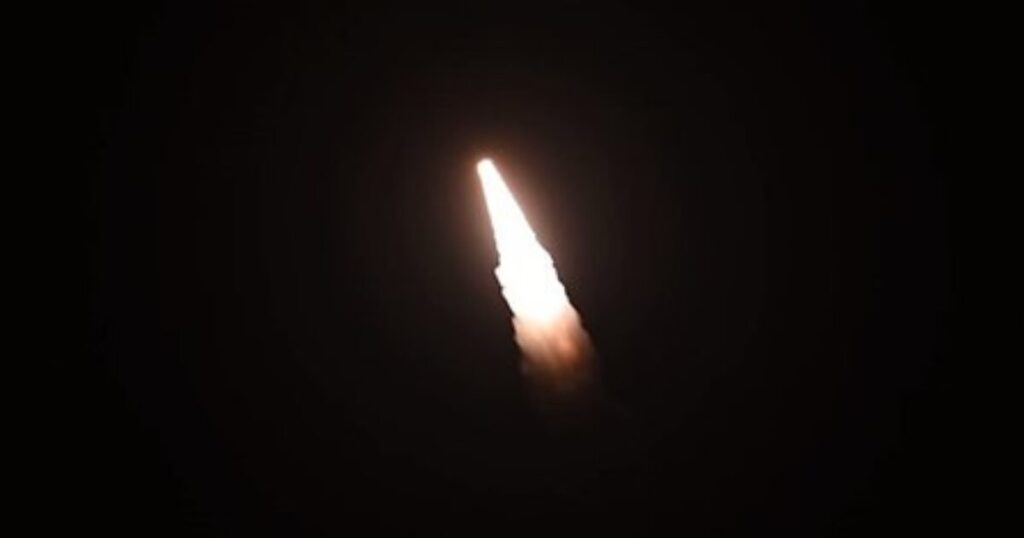On a recent evening, the United States military prepared to execute a hypersonic missile test at Vandenberg Space Force Base in California. This critical launch involved an unarmed Minuteman III intercontinental ballistic missile (ICBM), set to occur during a designated timeframe between 11:01 pm and 5:01 am Pacific Time. The missile was expected to cover an impressive distance of approximately 4,200 miles, reaching Kwajalein Atoll in the North Pacific within about 22 minutes. The Minuteman III is notable for its prowess, capable of attaining speeds exceeding 15,000 miles per hour, which allows it to strike global targets in a timeframe as short as 30 minutes. This test underscores the capabilities and readiness of the United States’ nuclear forces amidst escalating international tensions.
U.S. officials characterized the missile launch as a routine exercise, emphasizing its long-planned nature, claiming it was arranged years prior to the date of the actual test. They positioned the exercise as a demonstration of the United States’ nuclear deterrence capabilities, essential in maintaining a strategic balance given the rising signs of potential global conflict. Amidst the backdrop of international discord, particularly concerning Ukraine and North Korea, these tests serve a dual purpose: enhancing military readiness while also bolstering confidence in the U.S.’s nuclear arsenal. The current geopolitical climate, marked by increasing hostilities and alliances, has rendered such demonstrations of military capability particularly significant.
Notably, the timing of this missile test appeared to coincide with a series of alarming developments on the global stage. Just days ahead of the ICBM launch, North Korea announced a strategic alliance with Russia, indicating intentions to deploy forces to the ongoing conflict in Ukraine. Reports suggested that North Korean troops had begun their offensive against Ukrainian positions, further complicating an already volatile situation and enhancing concerns about an escalatory cycle of warfare involving multiple nations. This context marked the missile test as not just a technical exercise but a broader message regarding U.S. commitment to countering emerging threats and maintaining stability amidst increasing aggression from foreign adversaries.
In the wake of these developments, Russian Foreign Minister Sergei Lavrov expressed grave concerns regarding the potential for direct military confrontation between the United States and Russia. In statements to the Turkish media, Lavrov specifically cited President Joe Biden’s policies, alleging that they perpetuated a cycle of Russophobia that could lead to conflict. He emphasized that the election outcome, whether involving Kamala Harris or Donald Trump, would likely have minimal effect on Russian perceptions or policy, given Trump’s previously strong anti-Russian stance during his presidency. Such declarations highlight the fraught and delicate nature of diplomatic relations, especially with the emergence of new alliances and confrontational postures from nations like North Korea.
There is an additional layer of complexity with respect to geographical positioning that underscores the United States’ strategic focus. Both Russia and China, identified as principal adversaries on the global stage, are situated approximately the same distance from California, with Moscow at roughly 5,900 miles and Beijing at about 6,000 miles away. This close proximity greatly amplifies the implications of the missile test, as it puts both nations within the range of U.S. military capabilities and serves as a reminder of the continual need for preparedness in the face of potential threats. The strategic calculus of the U.S. military encompasses not only immediate threats but also the broader geopolitical landscape influenced by entrenched rivalries.
In anticipation of the missile launch, the broader context concerning U.S. military strategy was further reinforced by a recent exercise involving the same type of weapon. On June 4, a joint team from the Air Force Global Strike Command and Space Force Guardians conducted a successful test of an unarmed Minuteman III ICBM from Vandenberg Space Force Base previously. The cyclical nature of these tests serves to reaffirm the United States’ commitment to maintaining its nuclear arsenal while adapting to evolving threats in international relations. The importance of demonstrating military readiness and maintaining a credible deterrent factor cannot be overstated, especially in an era marked by increasing complexities on the global diplomacy front.
In summary, the imminent missile test at Vandenberg Space Force Base highlights both the significant capabilities of U.S. nuclear forces and the precarious global landscape characterized by potential conflict escalation between major powers. As geopolitical tensions mount, the implications of such tests extend beyond mere demonstration, encapsulating broader themes of deterrence and military preparedness. As nations like North Korea escalate their military involvements and Russian officials express concerns about the state of U.S.-Russia relations, the significance of these missile tests only grows, serving as focal points in a complex web of international diplomacy and military strategy. The United States continues to balance its historical role as a global military power with the need to navigate a rapidly shifting geopolitical order, with missile tests signaling both readiness and resolve in uncertain times.

